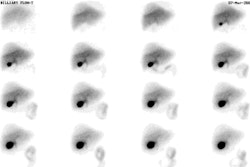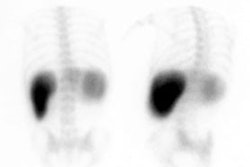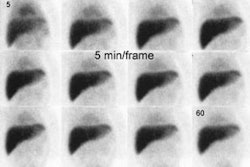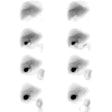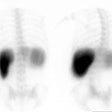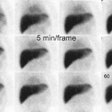Protocol for Cholecystokinin Cholescintigraphy for Gallbladder Ejection Fraction
Routine cholescintigraphy:
1. The patient should have nothing by mouth for 4 hours before the
exam. If fasting over
24 hours, the patient should receive a slow infusion of CCK before
initiating the study.
After CCK infusion, wait 30 min before radiopharmaceutical
injection to allow time for the
gallbladder to relax.
2. Camera: Large field of view, anterior projection
3. Computer set-up: 60 one minute frames
4. Patient set-up: Supine
5. Inject Tc-99m-mebrofenin or Tc-99m-disofenin 5 mCi (185 MBq)
I.V.
6. After the gallbladder has filled, usually at 60 minutes,
commence setup for CCK
cholescintigraphy
CCK Cholescintigraphy:
1. Computer set-up: 30 one minute frames
2. Place camera in the left anterior oblique projection to
minimize overlap of
gallbladder, small bowel, and common duct activity.
3. Infuse 0.02 ug/kg sincalide diluted in a 30-mL volume
continuously over 30 minutes
using a constant infusion pump or volutrol for intravenous rate
control. Recently, a 60 minute infusion has been suggested to
provide more consistent gallbladder contractility with imaging and
quantification over the entire 60 minute period [2,3].
4. On the computer, draw a region of interest around the
gallbladder and adjacent liver
background.
5. Generate a gallbladder back-ground corrected time-activity
curve.
6. Calculate the percentage of gallbladder emptying (GBEF): (max
counts-minimum
counts)/maximum counts
REFERENCES:
(1) J Nucl Med 1999; Ziessman HA. Cholecystokinin cholescintigraphy: Victim of its own success? 40: 2038-2042
(2) J Nucl Med 2010; Ziessman HA, et al. Sincalide-stimulated
cholescintigraphy: a multicenter investigation to determine
optimal infusion methodology and gallbladder ejection fraction
normal values: 51. 277-281
(3) J Nucl Med 2014; Ziessman HA. Hepatobiliary scinigraphy in 2014. 55: 967-975


